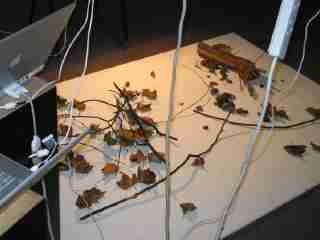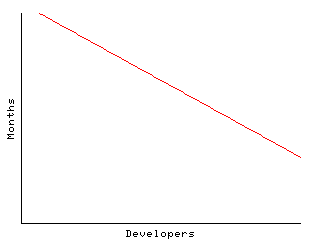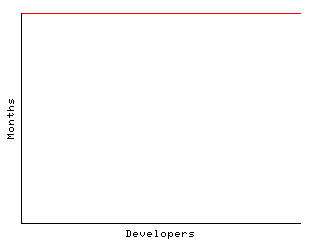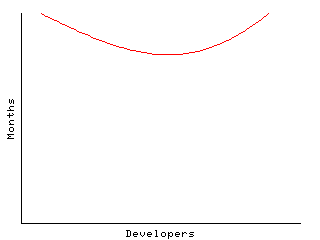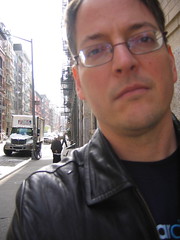I wanted to go to
CHI 2005, but things didn't work out. Second best is just reading the proceedings, but I'm too cheap to buy the proceedings. That leaves third best: reading the program online and googling the author names. You can find a good percentage of the papers that way without having to shell out major bucks. The only real downside is the inability to easily browse. You end up having to guess what might be interesting based on the titles. I decided to pick out five or so papers that had interesting or evocative or mysterious titles and see how they stacked up for:
- Inspiration
- Practical Advice
- Fun
The fun part is important when you're reading outside your direct field of expertise, things get boring pretty fast if you're lost. My favorite papers have all three, but I'll settle for just one, especially if it's a real hoot. I figured anything that included a contribution from the MIT Media Lab was bound to have a couple of side-splitting hoots. I wasn't disappointed.
Dishmaker: Personal Fabrication InterfaceLeonardo Bonanni, Sam Sarcia, Subodh Paudel, Ted Selker,
MIT Media Laboratory, USAFun factor off the scale, and inspirational to boot. No totally new ideas here, but the fact that they actually went and built the thing gets them massive points. Yes, they built a machine that on-demand manufactures your plates, bowls and cups just-in-time for dinner, then recycles them for breakfast. The fact that the plates are only 6 inches across (and look amazingly like the bowls, which look pretty much exactly like the cups) may impact the practicality, but in no way detracts from the pure geeky joy of the thing. Here's what the MIT Media Lab is good for: amusing me.
The paper is here somewhere:
http://web.media.mit.edu/~amerigo/, but you don't really get the full effect unless you look at the rest of the site.
Glimpse: a Novel Input Model for Multi-level DevicesClifton Forlines, Chia Shen,
Mitsubishi Electric Research Laboratories, USA; Bill Buxton,
Buxton Design, USAWhat's a Multi-level device, anyway? Well, now I know, it's a term you make up when you're trying very hard to come up with a use for pressure-sensitive touch pads/digitizing tablets. Not such a big deal in the past, when the main use was getting a better simulation of brush strokes in paint programs, but now that (evidently) every tablet PC comes with a pressure sensing surface, there's some (ehem) pressure to make use of it. The authors suggest a sort of tenative action, with a firm push to commit and a lift to undo, something like the way some digital camera shutter buttons have a "half-way-pushed" state. I'd have to try it out, it sounds a little hard to use, I know the camera shutter button thing takes some practice to get used to (I still occasionally take a picture when I'm just trying to lock the exposure). Fun factor gets a "meh," I was inspired to go try and figure out how to get the pressure data out of my tablet PC, so there's that, and I learned several things, so it was informative.
http://www.merl.com/publications/TR2005-024/Making Space for Stories: Ambiguity in the Design of Personal Communication SystemsPaul M. Aoki,
PARC (USA), Allison Woodruff,
Intel Research (USA)One of the "Best Paper" winners. I was interested enough when I thought I was going to learn about the effects of electronically mediated communication on face-saving strategies. (Think "I don't want to talk to/chat with this person, but I don't want to hurt their feelings and they don't want to think that I don't want to talk with them"), but then I found myself reading about how to apply Kerberos (kind of) to human interaction and I was hooked. Geeks do sociology. Fun (not Big Fun, but fun), inspirational, and interesting. And relatively short. It deserved the award.
http://www2.parc.com/csl/projects/audiospaces/pdf/Aoki-CHI2005-Ambiguity.pdfDesigning the Spectator ExperienceStuart Reeves,
University of Nottingham (UK), Steve Benford,
University of Nottingham (UK), Clare O'Malley,
University of Nottingham (UK), Mike Fraser,
University of Bristol (UK)Another "Best Paper" winner. I was prepared to be bored, but was encouraged by the brevity of the thing and decided to read it. I was glad. The paper strings together activities (or, rather, performances) as diverse as Dance Dance Revolution, photo booths, and looking through a telescope. You've got your basic "see the results of actions, can't see the results of actions" axis, and your "can see the actions themselves, can't see the actions themselves" axis, and you put the two of them together and come up with something interesting and, evidently, useful. I kept on thinking of waiting in a virtual line to play online Quake deathmatches, and how half the fun was watching the people ahead in line fight it out.
http://www.mrl.nott.ac.uk/%7Estr/projects/perf_inter.html
Urban Probes: Encountering Our Emerging Urban Atmospheres Eric
Paulos,
Intel Research (USA), Tom Jenkins,
Royal College of Art (UK)It's alt.chi (not that there's anything wrong with that), but even so, this one is a little silly. But it's too fun to resist, and for much the same reason as the Dishmaker: they actually went and built something instead of just theorizing. True, the thing they built is a trashcan that photographs and analyzes (then displays) each item of trash as it's thrown away, but that's not the point. The point is that they actually built something real. And I learned what a "probe" was. And I got to see Eric Paulos's web site:
http://berkeley.intel-research.net/paulos/tags:design,interaction,sigchi,conference,acm,2005

